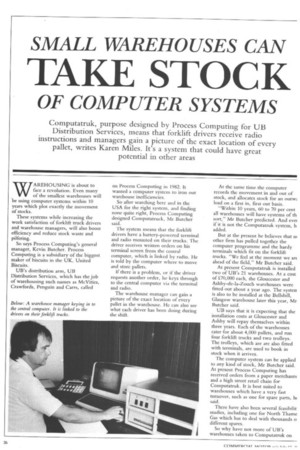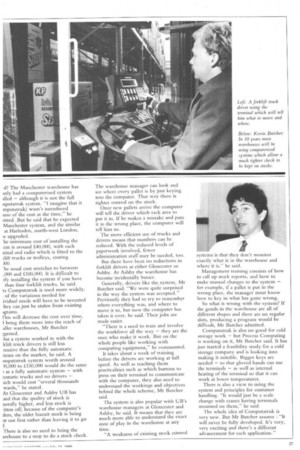SMALL WAREHOUSES CAN
Page 28

Page 29

If you've noticed an error in this article please click here to report it so we can fix it.
TAKE STOCK
OF COMPUTER SYSTEMS
Computatruk, purpose designed by Process Computing for UB Distribution Services, means that forklift drivers receive radio instructions and managers gain a picture of the exact location of every pallet, writes Karen Miles. It's a system that could have great potential in other areas
WAREHOUSING is about to face a revolution. Even many of the smallest warehouses will be using computer systems within 10 years which plot exactly the movement of stocks.
These systems while increasing the work satisfaction of forklift truck drivers and warehouse managers, will also boost efficiency and reduce stock waste and pilfering.
So says Process Computing's general manager, Kevin Butcher. Process Computing is a subsidiary of the biggest maker of biscuits in the UK, United Biscuits.
UB's distribution arm, UB Distribution Services, which has the job of warehousing such names as McVities, Crawfords, Penguin and Carrs, called on Process Computing in 1982. It wanted a computer system to iron out warehouse inefficiencies.
So after searching here and in the USA for the right system, and finding none quite right, Process Computing designed Computatruck, Mr Butcher said.
The system means that the forklift drivers have a battery-powered terminal and radio mounted on their trucks. The driver receives written orders on his terminal screen from the central computer, which is linked by radio. He is told by the computer where to move and store pallets.
If there is a problem, or if the driver requests another order, he keys through to the central computer via the terminal and radio.
The warehouse manager can gain a picture of the exact location of every pallet in the warehouse. He can also see what each driver has been doing during the shift.
At the same time the computer records the movement in and out of stock, and allocates stock for an outuf load on a first in, first out basis.
"Within 10 years, 60 to 70 per cent all warehouses will have systems of th sort," Mr Butcher predicted. And evei if it is not the Computatruk system, h. added.
But at the present he believes that n, other firm has pulled together the computer programme and the hardy terminals which fit on the forklift trucks. "We feel at the moment we art ahead of the field," Mr Butcher said.
At present Computatruk is installed two of UB's 21 warehouses. At a cost of £70,000 each, the Gloucester and Ashby-de-la-Zouch warehouses were fitted out about a year ago. The systerr is also to be installed at the Bellshill, Glasgow warehouse later this year, Mr Butcher said.
UB says that it is expecting that the installation costs at Gloucester and Ashby will repay themselves within three years. Each of the warehouses cater for about 4,000 pallets, and run four forklift trucks and two trolleys. The trolleys, which are are also fitted with terminals, are used to book in stock when it arrives.
The computer system can be applied to any kind of stock, Mr Butcher said. At present Process Computing has received orders from a paper merchants and a high street retail chain for Computatruk. It is best suited to warehouses which have a very fast turnover, such as one for spare parts, Iv said.
There have also been several feasibilit studies, including one for North Thamt Gas which has to deal with thousands o different spares.
So why have not more of UB's warehouses taken to Computatruk on .d? The Manchester warehouse has ntly had a computerised system tiled — although it is not the full nputatruk system. "I imagine that it mputatruk) wasn't introduced iuse of the cost at the time," he lifted. But he said that he expected Manchester system, and thc similar at Harlesden, north-west London, le upgraded.
'he minimum cost of installing the ern is around £40,000, with each ninal and radio which is fitted to the ;lift trucks or trolleys, costing 100.
lie usual cost stretches to between ,000 and £100,000. It is difficult to .ify installing the system if you have than four forklift trucks, he said. is Computatruk is used more widely, of the variations needed for ividual needs will have to be invented ley can just be stolen from existing 'grams.
['his will decrease the cost over time, I bring them more into the reach of aller warehouses, Mr Butcher ;gested.
3ut a system worked in with the klift truck drivers is still less aensive than the fully automatic ;terns on the market, he said. A Imputatruk system worth around )0,000 to £150,000 would do the same ) as a fully automatic system — with tomatic trucks and no drivers — iich would cost "several thousands wards," he stated.
At Gloucester and Ashby UB has and that the quality of stock is nerally higher, and less stock is itten off; because of the computer's tiers, the older biscuit stock is being at out first rather than leaving it to go F.
There is also no need to bring the arehouse to a stop to do a stock check. The warehouse manager can look and see where every pallet is by just keying into the computer. That way there is tighter control on the stock.
Once new pallets arrive the computer will tell the driver which rack area to put it in. If he makes a mistake and puts it in the wrong place, the computer will tell him so.
The more efficient use of trucks and drivers means that numbers can be reduced. With the reduced levels of paperwork involved, fewer administration staff may be needed, too.
But there have been no reductions in forklift drivers at either Gloucester or Ashby. At Ashby the warehouse has become incidentally busier.
Generally, drivers like the system, Mr Butcher said: "We were quite surprised in the way the system was accepted." Previously they had to try to remember where everything was, and where to move it to, but now the computer has taken it over, he said. Their jobs are made easier.
"There is a need to train and involve the workforce all the way — they are the ones who make it work. But on the whole people like working with computing equipment," he commented.
It takes about a week of training before the drivers are working at full speed. As well as teaching them practicalities such as which buttons to press on their terminal to communicate with the computer, they also need to understand the workings and objectives behind the whole scheme, Mr Butcher said.
The system is also popular with UB's warehouse managers at Gloucester and Ashby, he said. It means that they arc much more able to understand the exact state of play in the warehouse at any time.
"A weakness of existing stock aintrol systuns is that they don't monitor exactly what is in the warehouse and where it is," he said.
Management training consists of how to call up stock reports, and how to make manual changes to the system — for example, if a pallet is put in the wrong place, the manager must know how to key in what has gone wrong.
So what is wrong with the system? If the goods in the warehouse are all of different shapes and there are no regular slots, producing a program would be difficult, Mr Butcher admitted.
Computatruk is also no good for cold storage work — but Process Computing is working on it, Mr Butcher said. It has just started a feasibility study for a cold storage company and is looking into making it suitable. Bigger keys are needed — so that gloved hands can use the terminals — as well as internal heating of the terminal so that it can work at lower temperatures.
There is also a view to using the system and principles for container handling. "It would just be a scale change with cranes having terminals mounted on them," he said.
The whole idea of Computatruk is very new. But Mr Butcher assures : "It will never be fully developed. It's very, very exciting and there's a different advancement for each application."




















































































